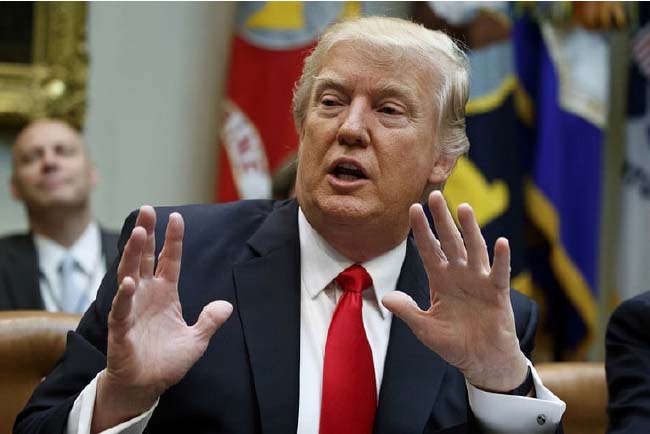Both Russia and the US hold the world’s largest nuclear stockpile, any mishaps in dealing with each other potentially alarms catastrophic consequences for the rest of the world. On the other hand, president Putin is all praises for Mr. Trump, openly applauding the American people for their choice to choose Mr. Trump. President Trump also recently thanked president Putin for calling him up to congratulate him on the elections win and once again prior to his inauguration as the 45th president of the US.
President Trump is certainly at no talking terms with the mainstream media that is constantly questioning his inner circle’s dealings with Moscow. During the campaign trail the then candidate Mr. Trump had to ask for his campaign chairman Paul Manafort’s resignation over his lobbying history, particularly in Ukraine, presenting pro-Russian interests. But president Trump voiced very clearly that he does not have any business interests in Russia, no loans in Russia, and reiterated that he has not even met president Putin personally. He added that he certainly hopes to get along with the guy, like many other leaders of states, but could possibly go the other way round too.
President Trump did also brush-off the scandalous confessions of the former British spy citing Russian authorities having a dossier on Mr. Trump showing him in compromising situations. Prior to running for President, Mr. Trump had visited Russia several times as the owner of Miss Universe Pigeon. Apparently, the secret dossier is orchestrated by the FSB formerly known as KGB with the commonly practiced Russian technique of setting up honey traps to blackmail politicians and businessmen. But the whole chapter of allegations faded away when both leaders labeled it fake and untrue.
No doubt, both Kremlin and Washington have to look for common grounds when it comes to easing international tensions bilaterally. The US having national security concerns in the Middle East, Asia, and Eastern Europe is fully aware of the Russian counter measures in these regions to safeguard their own. As former ambassador Khalilzad puts in his recent book (The Envoy), “despite the collapse of the then Soviet Union and the US emerging as the triumphant superpower, the old adversary has always been a prominent national security concern and a strategic threat for policy makers in the US who had prudently predicted a likely Russian aggression towards its eastern neighbors particularly Ukraine long time ago”.
The Russians on the other hand, are very sensitive to the increased NATO presence along their respective borders; they have taken counter measures by deploying tens of thousands of extra troops and heavy weaponry. Last year, when the US installed the previously halted missile defense shield in Romania, Moscow reacted and subsequently took proactive measures alongside its borders. In response NATO’s secretary general stated its defense essence, and subsequently rejected any claims of provocation by Moscow.
In the Middle East, Iran and Russia joined hands in Syria to save the falling Assad regime. From the very beginning they had sensed a western deception to shift the balance in the Middle East, and based on their assessment, the Syrian Assad would have been the last nail in the coffin. They acted quickly to prevent a regime collapse in Syria and materialized the Syrian government with both mercenaries and weapons to eventually weaken the very strongholds of IS and Syrian free army closing on Damascus.
Prior to the start of the Russian air campaign against the IS militants in Syria, the US along with its regional and European allies were already targeting IS strongholds in Iraq and Syria, paving the way for the moderate rebels to gain grounds and acquire political recognition. Temporary and short-lived but the world certainly witnessed a semi cooperative front between the US and Russia pouring bombs on IS to preclude their advancement.
In Asia, the Russians have strongly expressed their deepest concerns with the IS, gaining footholds in northern Afghanistan. Russian special envoy to Af-Pak Mr. Zamir Kabulov has acknowledged the fact that Moscow is indeed in talks with the Taliban to prevent any possible IS infiltration to its former Soviet Union republics, especially Tajikistan and Uzbekistan, both bordering Afghanistan. As a precaution Kremlin has indeed deployed its soldiers along the Afghan border to ensure the same. President Putin considers IS militants as a direct threat to Russia’s national security and global interests, simultaneously; Moscow has initiated multilateral talks with regional powers to create a buffer zone against these militants outside its respective borders. The U.S. on the other hand, under Trump administration is keen to extend a helping hand in this matter and open a unified front with Russia to wipe out IS and its royal affiliates in the region.
Last but not least, President Trump’s foreign policy and national security team led by defense secretary Gen. Mattis, director Pompeo, and secretary Tillerson will hold the key for any drastic change in the US Russia relations; it is likely to change to a lesser confrontational and more cooperation mode, in contrast to the previously cold personal relations between former president Obama and Russian president Vladimir Putin.

